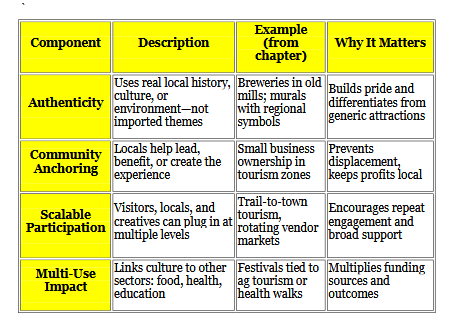The Foothills Corridor - Part IV - Weak Signal Strong Potential - Chapter 14: Reimagined
Part IV
Weak Signals with Strong Potential
Early Wins That Could Reshape the Region
By this point, we’ve seen the worst—and we’ve started to see what works. But what’s emerging now might be even more important: a series of small, early-stage efforts that aren’t fully scaled, but show real promise. These are the weak signals that—if nurtured, expanded, and connected—could become the spine of a new regional identity.
This is the critical middle ground between failure and transformation. These projects and movements aren’t just ideas anymore. They have funding. They have structure. They have champions. But they’re still fragile. Still evolving. Still vulnerable to being ignored, underfunded, or siloed.
This chapter focuses on the in-between stories—the efforts that aren’t yet institutions, but could become them. These are the seeds of systemic change, and how we treat them now will determine whether the Foothills builds a future on foundation or on sand.
What’s featured here isn’t hype—it’s potential. And if the region gets behind it, supports it strategically, and refuses to let momentum die in isolation, that potential becomes the new playbook for post-industrial resilience.
Because the next phase of revival doesn’t start from scratch.
It starts right here.
Chapter 14
Craft Beer, Tourism, and Heritage Reimagined
The Foothills Corridor has always had stories to tell—it just didn’t always have the packaging, the platform, or the strategy to tell them well. That’s changing. A quiet reimagining of craft beer, tourism, and cultural heritage is taking root across the region, offering a new kind of economic engine: one rooted in experience, narrative, and local pride.
While it’s easy to dismiss breweries and tourism trails as trendy or secondary, they are—when done right—high-leverage catalysts for broader revitalization. They draw foot traffic, attract outsiders, fuel small business growth, and provide young people with a reason to stick around.
And in the Foothills, they’re starting to do just that.
Brewing More Than Beer
Take Catawba Brewing Co., which began in the Foothills before expanding to Asheville, Charlotte, and beyond. It didn’t just pour drinks—it poured belief back into downtowns. The same is happening with small craft breweries in Morganton, Newton, and Lenoir. These aren’t just watering holes—they’re community hubs.
They employ local labor. They use local ingredients. They collaborate with food trucks, musicians, and artists. They fill the void left by shuttered retail, and they transform once-vacant buildings into places worth gathering in again.
More importantly, they become part of the region’s identity export. Visitors who come for the beer leave with a new understanding of what the Foothills is—and what it could be.
Heritage That Works
Too often, heritage in rural America is stuck in the past. Museums with dated exhibits. Walking tours no one takes. Nostalgia with no strategy. But in the Foothills, there’s an opportunity to activate heritage, not just remember it.
What if furniture factories became design labs? What if textile mills hosted maker markets? What if agrarian heritage was tied to culinary trails and food hubs?
This is already starting to happen in places like Valdese and North Wilkesboro, where local history is being reinterpreted through events, exhibits, and business models that appeal to new generations. The past isn’t a weight—it’s a launchpad.
Destination Development, Not Just Tourism
Tourism isn’t about brochures anymore—it’s about building destinations that deliver on experience. The Foothills is rich in assets: rivers, trails, rail history, music roots, and Appalachian overlap. But the key is curating those assets into something cohesive.
That’s what the emerging Craft Beverage Trails, outdoor recreation maps, and regional event calendars are starting to do. They tell a story that says: "This place is not just surviving. It’s worth the drive."
Why It Matters
Tourism, craft culture, and heritage reimagining aren’t just window dressing. They’re entry points into the economy—for creatives, entrepreneurs, and returning residents. They support hospitality. They boost downtown vibrancy. They raise the profile of towns that have long been ignored.
And perhaps most importantly, they rebuild narrative control. For too long, the Foothills has been defined by what it lost. Now it’s being redefined by what it makes, what it preserves, and what it shares.
This kind of renaissance isn’t loud. But it’s sticky. People remember experiences. They come back for culture. They invest in stories that feel real. And when a region tells its own story with pride, the outside world finally starts to listen.
Craft beer, tourism, and heritage won’t rebuild the economy alone. But they will rebuild the reason people want to be here. And that’s where every comeback begins.
Tourism can energize a local economy, but it’s also fickle. It rises and falls with consumer trends, economic cycles, and marketing fads. Without deeper industrial or entrepreneurial anchors, a tourism-heavy strategy can leave communities exposed when tastes or times change.


